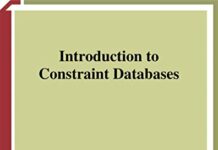
Ebook Info
- Published: 2010
- Number of pages: 760 pages
- Format: PDF
- File Size: 7.66 MB
- Authors: Peter Revesz
Description
Introduced forty years ago, relational databases proved unusually succe- ful and durable. However, relational database systems were not designed for modern applications and computers. As a result, specialized database systems now proliferate trying to capture various pieces of the database market. Database research is pulled into di?erent directions, and speci- ized database conferences are created. Yet the current chaos in databases is likely only temporary because every technology, including databases, becomes standardized over time. The history of databases shows periods of chaos followed by periods of dominant technologies. For example, in the early days of computing, users stored their data in text ?les in any format and organization they wanted. These early days were followed by information retrieval systems, which required some structure for text documents, such as a title, authors, and a publisher. The information retrieval systems were followed by database systems, which added even more structure to the data and made querying easier. In the late 1990s, the emergence of the Internet brought a period of relative chaos and interest in unstructured and “semistructured data” as it wasenvisionedthateverywebpagewouldbelikeapageinabook.However, with the growing maturity of the Internet, the interest in structured data was regained because the most popular websites are, in fact, based on databases. The question is not whether future data stores need structure but what structure they need.
User’s Reviews
Editorial Reviews: Review From the reviews:“Offers an introduction to modern databases. … In this well-organized book, the presentation is simple and easy to understand. As a result, students will find this introductory textbook useful. Furthermore, they will benefit from its numerous illustrative examples, exercises, and bibliographic notes. … The book offers an interesting perspective into the many specialized databases that are currently in existence–something virtually no other book on the market offers. … In short, I strongly recommend it to readers who are interested in databases.” (S. V. Nagaraj, ACM Computing Reviews, February, 2011)“A book that covers all the modern turns and directions that databases have taken in recent years. … Overall, this is a very valuable addition to the database textbook literature. The author claims that the primary audience for this book are undergraduates, but I believe that it can and will reach beyond that level of database education.” (Gottfried Vossen, Zentralblatt MATH, Vol. 1191, 2010) From the Back Cover Developments in modern computers and applications have resulted in a shift away from relational databases into a chaotic proliferation of specialized database systems. As many of these advanced databases are unable to communicate with each other, database interoperability and data integration have become important challenges. The search for a suitable common standard for the numerous varieties of current databases has generated renewed interest in extensions of relational databases, such as constraint databases.This unique, reader-friendly textbook/reference provides a comprehensive coverage of the field of databases. Introduction to Databases reveals a deep insight into the workings of numerous database systems, enabling readers to develop complex and rewarding database applications. Students will gain hands-on experience by following the suggested exercises, and are offered the support to begin their own research projects in database systems. The theory covered is complemented by a detailed examination of specific applications from a broad range of diverse areas. The text assumes as prerequisite only basic discrete mathematics, linear algebra, and programming knowledge.Topics and features:• Provides chapter-by-chapter descriptions of eleven different types of databases, and presents the MLPQ and the DISCO database systems that implement several different types of databases• Concludes each chapter with bibliographic notes and an extensive set of exercises• Examines database design, including advanced database application issues of database interoperability, data integration, interpolation and approximation, and prediction and data mining• Presents the MLPQ system, together with slides, solutions (for instructors), and other course aids at the supporting website: http://cse.unl.edu/~revesz• Covers topics on indexing methods, data visualization, the safety of queries, general evaluation algorithms, the efficient implementation of evaluation algorithms, and the complexity of the evaluation of different types of queries• Structured to allow for flexible course design, with courses suggested in the PrefaceAn essential resource for advanced undergraduate students, even non-computer science students with little prior exposure to databases will find this a clear introduction to the theory, the various types of databases and their applications. Professional database experts will also find this a valuable reference.Dr. Peter Revesz is a professor in the Department of Computer Science and Engineering at the University of Nebraska-Lincoln and has held visiting appointments at, among other places, the IBM T.J. Watson Research Center, INRIA, and the Max Planck Institute for Computer Science. Other titles by this author include the successful Springer textbook Introduction to Constraint Databases. About the Author Dr. Peter Revesz is a professor in the Department of Computer Science and Engineering at the University of Nebraska-Lincoln and has held visiting appointments at, among other places, the IBM T.J. Watson Research Center, INRIA, and the Max Planck Institute for Computer Science. Other titles by this author include the successful Springer textbook Introduction to Constraint Databases. Read more
Reviews from Amazon users which were colected at the time this book was published on the website:
⭐Great Book! Needs more Examples though
Keywords
Free Download Introduction to Databases: From Biological to Spatio-Temporal (Texts in Computer Science) 2010th Edition in PDF format
Introduction to Databases: From Biological to Spatio-Temporal (Texts in Computer Science) 2010th Edition PDF Free Download
Download Introduction to Databases: From Biological to Spatio-Temporal (Texts in Computer Science) 2010th Edition 2010 PDF Free
Introduction to Databases: From Biological to Spatio-Temporal (Texts in Computer Science) 2010th Edition 2010 PDF Free Download
Download Introduction to Databases: From Biological to Spatio-Temporal (Texts in Computer Science) 2010th Edition PDF
Free Download Ebook Introduction to Databases: From Biological to Spatio-Temporal (Texts in Computer Science) 2010th Edition
